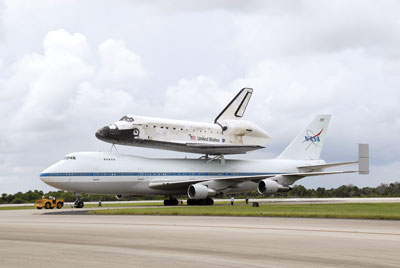
Features
Operations
Waypoint: Continuing to explore new frontiers
I am an addict of anything that involves space, real or fictional.
July 10, 2012 By Rob Seaman
I am an addict of anything that involves space, real or fictional. I remember sitting on the living room floor, watching black-and-white grainy TV – with rabbit ears for the antenna and only three stations to choose from – and seeing John Glenn on his history-setting orbit of the Earth. As a youngster, I watched every launch and landing (or splashdown as it was then) that NASA broadcast. Even launches for shuttle flights gave me pause to sit and observe, long after it was fashionable to do so.
 |
|
| Hopefully, in its new home as part of the Smithsonian, the shuttle will be appreciated and immortalized. PHOTO: NASA
|
Many years ago, I had the opportunity to tour the Kennedy Space Center (KSC) at Cape Canaveral in Florida. It was a time when the Apollo program was over and the shuttle missions had not quite started. The museum at KSC was deserted and one of the staff offered to give me a one-on-one tour. We drove around the premises and I saw things I would not otherwise get to – including a visit to the launch pad where Glenn’s Friendship 7 launched. For a space junkie it was a chance to experience history firsthand.
Thoughts of this day came to mind recently as I watched one of the now-retired space shuttles being delivered on the back of a 747 to its new home in Washington, D.C. It was encouraging that the media were once again paying attention to one of man’s greatest achievements. Hopefully, in its new home at the Smithsonian, the shuttle will be appreciated and immortalized as a long-standing credit to the space program past and an inspiration to future space exploration.
The event made me analyze Canada’s contribution to space exploration as well. Many believe our astronauts and the iconic Canadarm are the country’s main contributions to the NASA space program. In reality, these represent only two key elements in the process.
The Canadian Space Agency was established in 1989, focusing on development of space exploration for the country’s social and economic benefit. However, this nation’s involvement predates this time frame considerably. In 1959, Canada signed an agreement with NASA for its first satellite. The design, financing, research and even construction were made here in Canada while launching facilities were provided through NASA. Accordingly in 1962, Alouette 1 took flight, followed, in 1965, by Alouette 2. Additional satellite designs and launches followed and it wasn’t until 1981 that the first operational use of Canadarm occurred in space flight. Thus came an age where Canadian astronauts and technology would work in unison above our little blue planet – a process that continues to this day.
Canada’s contribution to space exploration also has a far less public history. When the Avro Arrow supersonic fighter jet was cancelled in 1959, some of the greatest and most talented engineers ever assembled were suddenly out of work. These talented people – some 25 engineers from the Arrow program – were “borrowed” by NASA to work on the development of Project Mercury. At the time, the expectation was they would return to work at Avro; but when the company ultimately failed, their “loan” to NASA became permanent.
Some of the standout names from the Canadian group include Jim Chamberlain, who led the team in the development of the Mercury Project. John Hodge was named flight director on the Mercury team, then Gemini and Apollo spacecraft. Fred Matthews earned a role as a backup flight director. Tec Roberts was in charge of the trajectory group in mission control, and then was credited with the design of NASA’s Mission Control Center in Houston. Owen Maynard was chief of systems engineering division on the Apollo program and played a big part in the development of Lunar Module “Eagle” – the craft that put Neil Armstrong and Buzz Aldrin on the moon.
Outside of NASA – but still an important part of the program – there was Robert Lindley, chief engineer at Avro at the time of the cancellation. He jumped to McDonald Aviation and was in charge of its work on the Gemini spacecraft. Lindley later moved to NASA to work on the shuttle program.
Mario Pesando, who was chief of project research for the Arrow, moved to RCA headquarters in Massachusetts to work on the Saturn 5 project that launched astronauts to the moon. Carl Lindo, a project manager on the Arrow, went to Boeing to become a project engineer on Saturn rocket proposals.
While the names and contributions of these Canadians are not common knowledge in mainstream media, their efforts were certainly critical in putting Canadians on the space exploration map – and they deserve top recognition, even though their efforts were galvanized south of the border.
Rob Seaman is a Wings writer and columnist.